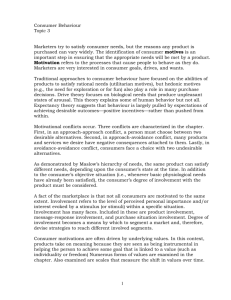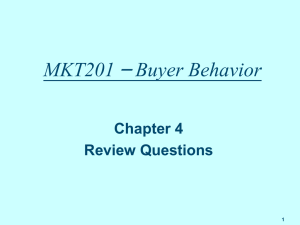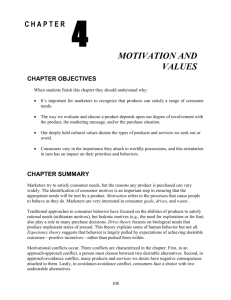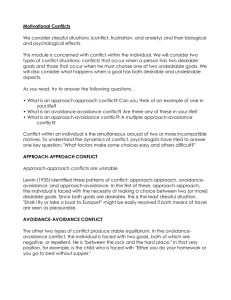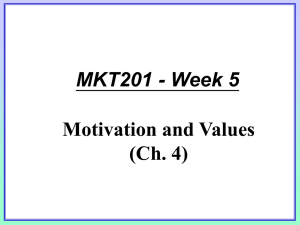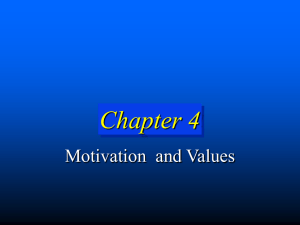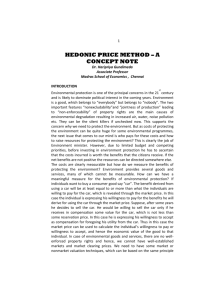Involvement
advertisement
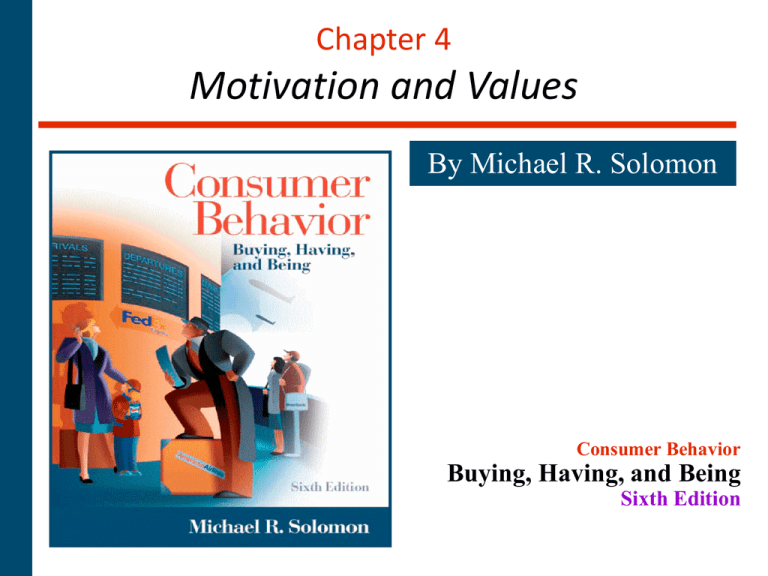
Chapter 4 Motivation and Values By Michael R. Solomon Consumer Behavior Buying, Having, and Being Sixth Edition The Motivation Process • Motivation: – The processes that lead people to behave as they do. It occurs when a need arises that a consumer wishes to satisfy. • Utilitarian need: Provides a functional or practical benefit • Hedonic need: An experiential need involving emotional responses or fantasies • Goal: – The end state that is desired by the consumer. The Motivation Process • Drive: – The degree of arousal present due to a discrepancy between the consumer’s present state and some ideal state • Want: – A manifestation of a need created by personal and cultural factors. • Motivation can be described in terms of: – Strength: The pull it exerts on the consumer – Direction: The particular way the consumer attempts to reduce motivational tension Ads Reinforce Desired States • This ad for exercise shows men a desired state (as dictated by contemporary Western culture), and suggests a solution (purchase of equipment) to attain it. Motivational Strength • Biological vs. Learned Needs: – Instinct: Innate patterns of behavior universal in a species – Tautology: Circular explanation (e.g. instinct is inferred from the behavior it is supposed to explain) • Drive Theory: – Biological needs produce unpleasant states of arousal. We are motivated to reduce tension caused by this arousal. – Homeostasis: A balanced state of arousal • Expectancy Theory: – Behavior is pulled by expectations of achieving desirable outcomes – positive incentives – rather than pushed from within Motivational Direction • Needs Versus Wants: – Want: The particular form of consumption used to satisfy a need. • Types of Needs – Biogenic needs: Needs necessary to maintain life – Psychogenic needs: Culture-related needs (e.g. need for status, power, affiliation, etc.) – Utilitarian needs: Implies that consumers will emphasize the objective, tangible aspects of products, a desire to achieve some functional or practical benefit. – Hedonic needs: Subjective and experiential needs (e.g. excitement, self-confidence, fantasy, etc.) A tension! • With the consideration of unmet needs, a discrepancy exists between the consumer’s present state and some ideal state. Tension is created. The consumer seeks to reduce this tension. The degree of arousal is called a drive. • Marketers try to create products and services that will provide the desired benefits and permit the consumer to reduce this tension. State your ends! • The desired end state is the consumer’s goal. • Once a goal is attained, tension is reduced and the motivation recedes. • Motivation can be described in terms of: a) Its strength b) Its direction Strength and Direction • Motivational Strength The degree to which a person is willing to expend energy to reach one goal as opposed to another reflects his or her underlying motivation to attain that goal. • Motivational Direction: Motives have direction as well as strength. Most goals can be reached by a number of paths. The specific way a need is satisfied depends on the individual’s unique history, learning experiences, and his or her cultural environment. Particular form of consumption used to satisfy a need is termed a want. Conflicts can occur... • Motivational Conflicts A goal has valence, which means that it can be positive or negative. Therefore goals can be sought or avoided. Not all behavior is motivated by the desire to approach a goal. Consumers often find themselves in situations in which different motives, both positive and negative, conflict with one another - i.e. Conflicts can occur. Three different types of goal conflicts are: Approach-approach conflict, Approach-avoidance conflict, Avoidance-avoidance conflict. Instant Gratification of Needs • We expect today’s technical products to satisfy our needs – instantly. Motivational Conflicts • Approach-Approach Conflict: – A person must choose between two desirable alternatives. – Theory of Cognitive Dissonance: A state of tension occurs when beliefs or behaviors conflict with one another. • Cognitive Dissonance Reduction: Process by which people are motivated to reduce tension between beliefs or behaviors. • Approach-Avoidance Conflict: – Exists when consumers desire a goal but wish to avoid it at the same time. Many products and services we desire have negative consequences attached to them. • Avoidance-Avoidance Conflict: – Consumers face a choice between two undesirable alternatives. Three Types of Motivational Conflicts Figure 4.1 A Gentle Approach... • In approach-approach conflicts, marketing communications should emphasize a “no-lose” and/or “win either way” message(s). • In approach-avoidance conflicts, messages should accentuate the positive aspects and either downplay the negative or provide some additional counterbalancing information about the choices. • In avoidance-avoidance conflicts, messages should emphasize the need for making a choice and link it to some other more attractive value held by the consumer. Solutions to Approach-Avoidance Conflict approach-avoidance Discussion Question • Do sporting events, such as a college football game, satisfy utilitarian or hedonic needs? Which specific needs do they address? • Give some other examples of utilitarian and hedonic needs. Classifying Consumer Needs • Henry Murray need dimensions: – Autonomy: Being independent – Defendance: Defending the self against criticism – Play: Engaging in pleasurable activities • Thematic Apperception Technique (TAT): – (1) What is happening? – (2) What led up to this situation? – (3) What is being thought? – (4) What will happen? – People freely project their subconscious needs onto the stimulus Theory of cognitive dissonance • An illustration—a person purchases an expensive automobile with the expectation that it will increase his or her status within his or her social set. However, the increased status does not occur and he or she begins to doubt that the purchase was a wise idea. If unchecked, this doubt can create grave negative feelings about the automobile and the dealer that sold it to the person. However, dissonance reduction will occur if friends compliment the person or make it known to them that the purchase was a good one. In lieu of friends performing this role, the marketer must sometimes perform the confirmation role by running reassurance ads for their customers. Classifying Consumer Needs (cont.) • Specific Needs and Buying Behavior: – – – – Need for achievement: To attain personal accomplishment Need for affiliation: To be in the company of others Need for power: To control one’s environment Need for uniqueness: To assert one’s individual identity • Maslow’s Hierarchy of Needs: – A hierarchy of biogenic and psychogenic needs that specifies certain levels of motives. • Paradise: Satisfying Needs? – Distinct differences regarding the conceptualization of paradise between American and Dutch college students Maslow’s Hierarchy of Needs Figure 4.2 Dutch Conception of Paradise • A Dutch respondent’s collage emphasizes this person’s conception of paradise as a place where there is interpersonal harmony and concern for the environment. All you need is love... Appeal to Affiliation Needs Criticisms of Maslow’s Hierarchy • The application is too simplistic: – It is possible for the same product or activity to satisfy every need. • It is too culture-bound: – The assumptions of the hierarchy may be restricted to Western culture • It emphasizes individual needs over group needs – Individuals in some cultures place more value on the welfare of the group (belongingness needs) than the needs of the individual (esteem needs) Involvement • Involvement refers to the level of perceived personal importance and/or interest evoked by a stimulus (or stimuli) within a specific situation. Involvement can be: product involvement, message-response involvement, and purchase situation involvement. Degree of involvement becomes a means by which to segment a market and, therefore, devise strategies to reach different involved segments. Are you involved? • Involvement can be viewed as the motivation to process information. As involvement increases, people devote more attention to ads related to the product, exert more cognitive effort to understand these ads, and focus their attention on the productrelated information in them. Your Attention Please.... • It is known that consumers differ in their level of involvement with a product message. Marketers use attention-getting factors to ensure that messages get through the clutter that constantly bombards the consumer’s senses Technically Speaking.... The techniques cited in the text that can be used to enhance the consumer’s motivations to process product information and increase their involvement: • (a) Appeal to consumers’ hedonic needs (e.g., ads using sensory appeals generate higher levels of attention). • (b) Use novel stimuli in a commercial, such as unusual cinematography, sudden silences,or unexpected movements. • (c) Use prominent stimuli, such as loud music and fast action, to capture attention in commercials. In print formats, larger ads increase attention. Also, viewers look longer at full-color pictures than at black-and-white. • (d) Include celebrity endorsers in commercials to generate higher interest. • (e) Develop a bond (i.e., brand loyalty) by maintaining an ongoing relationship with consumers. Consumer Involvement • Involvement: – A person’s perceived relevance of the object based on his/her inherent needs, values, and interests. • Object: A product or brand • Levels of Involvement: Inertia to Passion – Type of information processing depends on the consumer’s level of involvement • Simple processing: Only the basic features of the message are considered • Elaboration: Incoming information is linked to preexisting knowledge Conceptualizing Involvement Figure 4.3 Increasing Involvement through Ads • The Swiss Potato Board is trying to increase involvement with its product. The ad reads, “Recipes against boredom.” Consumer Involvement (cont.) • Involvement as a Continuum: – Ranges from disinterest to obsession • Inertia (Low involvement consumption): – Consumer lacks the motivation to consider alternatives • Flow State (High involvement consumption): – Consumer is truly involved with the product, ad or web site • Cult Products: – Command fierce consumer loyalty and perhaps worship by consumers who are highly involved in the product Example of a Cult Product The Many Faces of Involvement • Product Involvement: – Related to a consumer’s level of interest in a particular product • Message-Response Involvement: – (a.k.a. advertising involvement) Refers to a consumer’s interest in processing marketing communications. Television is considered a low-involvement medium. Print is considered a high-involvement medium. • Purchase Situation Involvement: – Refers to the differences that may occur when buying the same product for different contexts. Social risk is considered. Emotions versus Cognitions • Many marketing messages, such as this ad for a cosmetic company in Taiwan, focus on emotions rather than cognitions. Measuring Involvement • Teasing out the Dimensions of Involvement: – Involvement Profile: • • • • • Personal interest in a product category Risk importance Probability of making a bad purchase Pleasure value of the product category How closely the product is related to the self • Segmenting by Involvement Levels: – Involvement is a useful basis for market segmentation High Involvement Underlying values • Consumer motivations are often driven by underlying values. In this context, products take on meaning because they are seen as being instrumental in helping the person to achieve some goal that is linked to a value (such as individuality or freedom) Strategies to Increase Involvement • Appeal to hedonic needs – e.g. using sensory appeals to generate attention • Use novel stimuli – e.g. unusual cinematography, sudden silences, etc. • Use prominent stimuli – e.g. larger ads, more color • Include celebrity endorsers • Build a bond with consumers – Maintain an ongoing relationship with consumers Values • Value: – A belief that some condition is preferable to its opposite (e.g. freedom is better than slavery) • Core Values: – General set of values that uniquely define a culture • Value system: A culture’s unique set of rankings of the relative importance of universal values. What sets cultures apart is the relative importance or ranking of universal values. This set of rankings is a culture’s value system. • Every culture is characterized by its members’ endorsement of a value system. – Enculturation: • Process of learning the value systems of one’s own culture – Acculturation: • Process of learning the value system of another culture – Cultural beliefs are taught by socialization agents (i.e., parents, friends, and teachers) Core Values • Cleanliness is a core value in many cultures. Application of Values to Consumer Behavior • Useful distinctions in values for consumer behavior research – Cultural Values (e.g. security or happiness) – Consumption-Specific Values (e.g. convenient shopping or prompt service) – Product-Specific Values (e.g. ease-of-use or durability) • Virtually all consumer research is ultimately related to identification and measurement of values. Emotions versus Cognitions • The positive value we place on the activities of large corporations is changing among some consumers who prefer to go “anticorporate.” This ad for a coffee shop in Boulder, Colorado reflects that sentiment. Measuring Cultural Values • The Rokeach Value Survey – Terminal Values: Desired end states – Instrumental Values: Actions needed to achieve terminal values • The List of Values (LOV) Scale – Developed to isolate values with more direct marketing applications – Identifies nine (9) consumer segments based on the values they endorse – Relates each value to differences in consumption The Means-End Chain Model • Laddering: – A technique that uncovers consumers’ associations between attributes and consequences • Hierarchical value maps: – Show how product attributes are linked to desired end states • Means-End Conceptualization of the Components of Advertising Strategy (MECCAS): • • • • • Message Elements Consumer Benefits Executional Framework Leverage Point Driving Force Advertising uses the laddering concept to develop advertising strategy Elements include • a. Message elements—which attributes or product features. • b. Consumer benefit—positive consequences of use. • c. Executional framework—style and tone of ad. • d. Leverage point—how to link terminal values with product features. e. Driving force—end value on which the advertising will focus. Chained to a Model...Hm... • The Means-End Chain Model assumes that very specific product attributes are linked at levels of increasing abstraction to terminal values. The person has valued end states, and he or she chooses among alternative means to attain these goals. Products are thus valued as the means to an end. Through a technique called laddering, consumer’s associations between specific attributes and general consequences are uncovered. Consumers are helped to climb up the “ladder” or abstraction that connects functional product attributes with desired end states. The Weight of your Chains.... • Example: a young man purchases a diamond ring to symbolize an upcoming marriage to a young woman. Concrete attributes like size and clarity of the stone are parlayed into abstract and emotional values of love and selfesteem (yes, carat weight and quality do matter--especially to women). Materialism • Materialism: – The importance people attach to worldly possessions – Tends to emphasize the well-being of the individual versus the group – People with highly material values tend to be less happy – America is a highly materialistic society – There are a number of anti-materialism movements Values of Materialists • Materialists value visible symbols of success such as expensive watches. Consumer Behavior in the Aftermath of 9/11 • Following 9/11, ads addressed people’s fears in various ways. This ad was created as part of the Advertising Community Together initiative.
